University Name: Abnormal Psychology Case Study - Derek's OCD Symptoms
VerifiedAdded on 2020/05/11
|5
|1152
|69
Case Study
AI Summary
This case study examines Derek, a 51-year-old male with Obsessive-Compulsive Disorder (OCD). Derek exhibits symptoms including obsessions with neatness, order, and numerous phobias, significantly impacting his personal and professional life. The assignment details Derek's history, including the emotional distress following his wife's death, leading to social withdrawal and the development of compulsions. His diagnosis is OCD, based on the DSM-5 criteria, and the assignment outlines various treatment approaches, including psychodynamic psychotherapy, pharmacological interventions (SSRIs, clomipramine), and behavioral therapies such as exposure and response prevention. The case study emphasizes the importance of both medication and psychotherapy for effective management of OCD, highlighting the potential for long-lasting effects from behavioral therapy. The references cited include the DSM-5 and other relevant research articles.
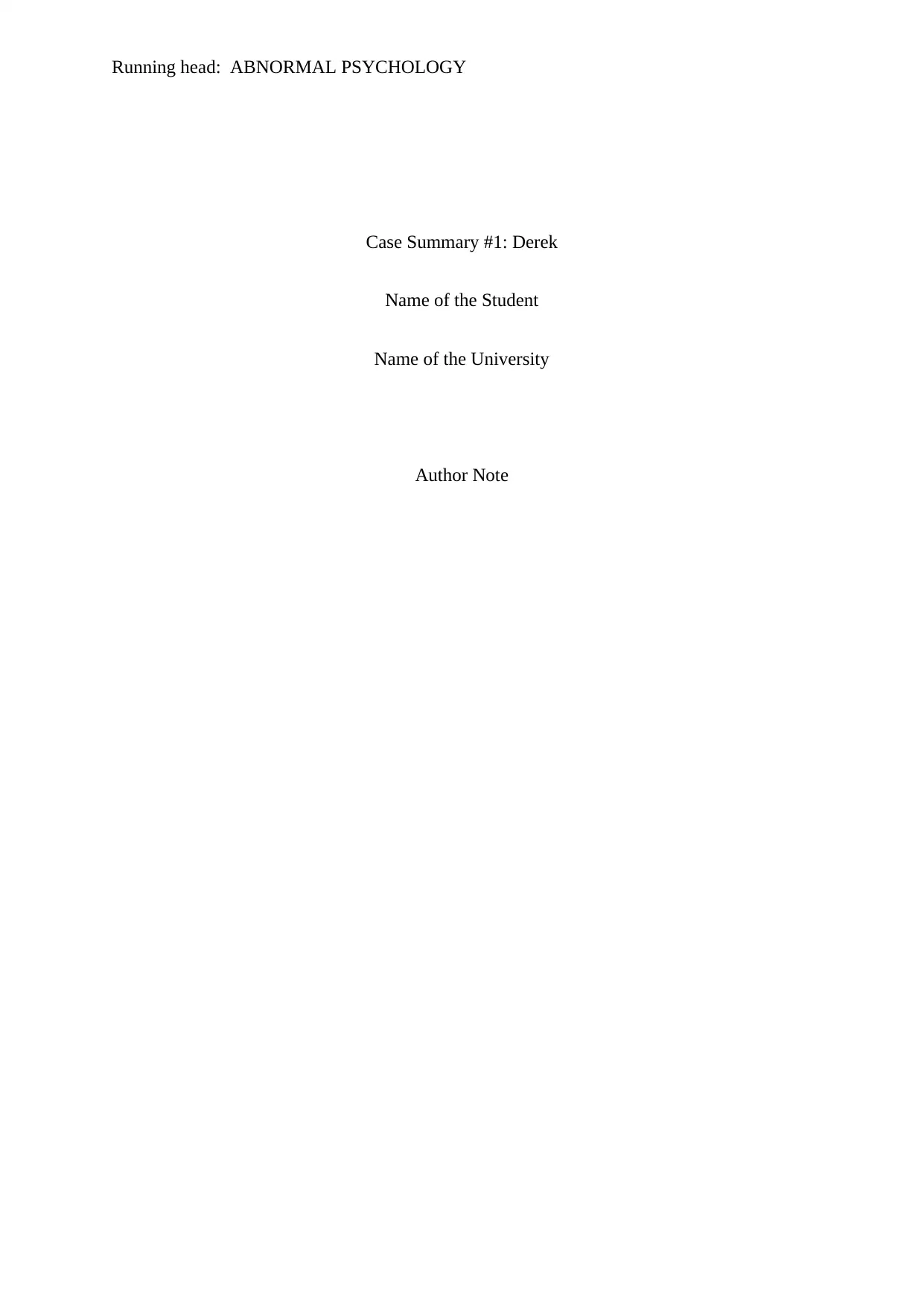
Running head: ABNORMAL PSYCHOLOGY
Case Summary #1: Derek
Name of the Student
Name of the University
Author Note
Case Summary #1: Derek
Name of the Student
Name of the University
Author Note
Paraphrase This Document
Need a fresh take? Get an instant paraphrase of this document with our AI Paraphraser
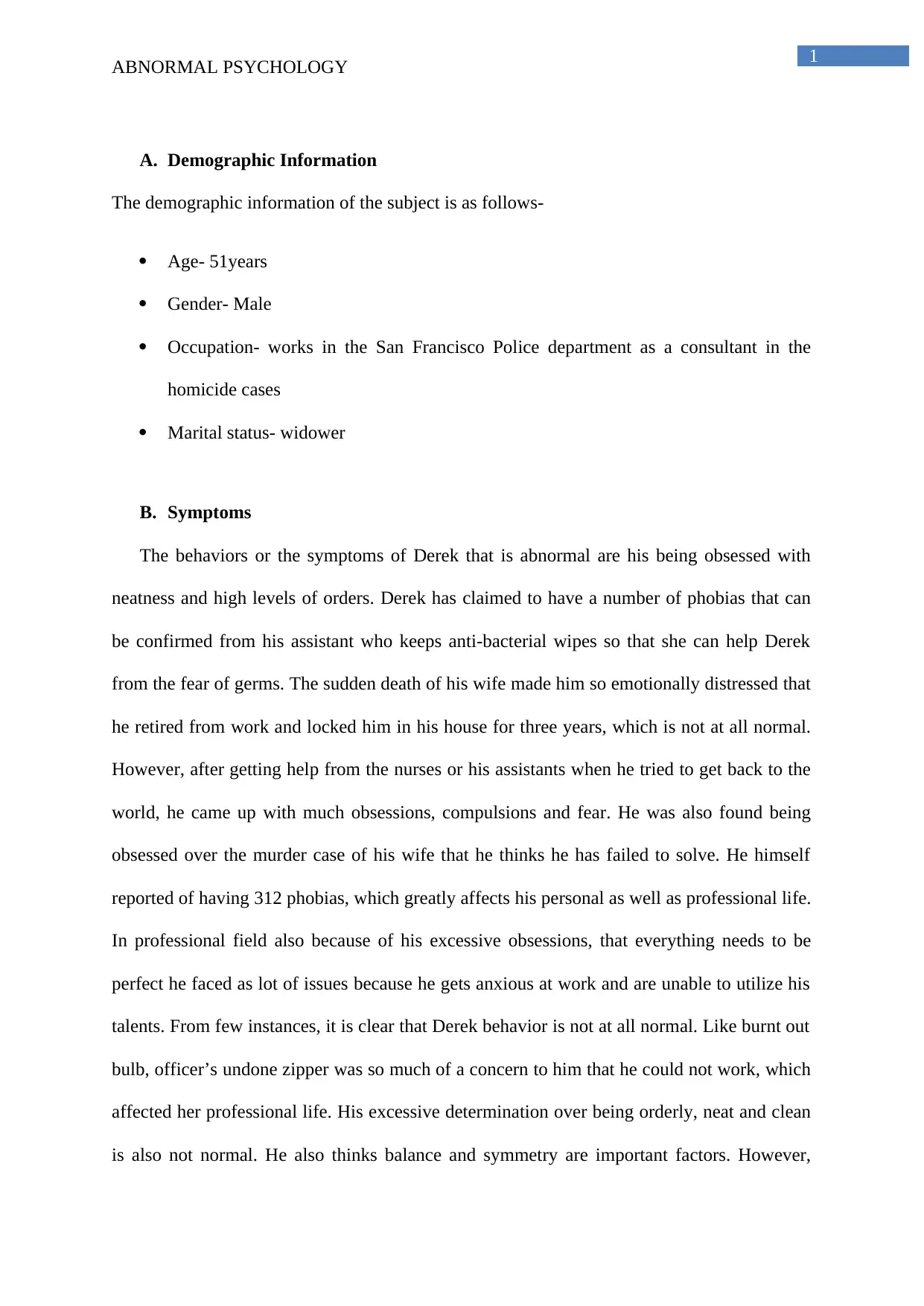
1
ABNORMAL PSYCHOLOGY
A. Demographic Information
The demographic information of the subject is as follows-
Age- 51years
Gender- Male
Occupation- works in the San Francisco Police department as a consultant in the
homicide cases
Marital status- widower
B. Symptoms
The behaviors or the symptoms of Derek that is abnormal are his being obsessed with
neatness and high levels of orders. Derek has claimed to have a number of phobias that can
be confirmed from his assistant who keeps anti-bacterial wipes so that she can help Derek
from the fear of germs. The sudden death of his wife made him so emotionally distressed that
he retired from work and locked him in his house for three years, which is not at all normal.
However, after getting help from the nurses or his assistants when he tried to get back to the
world, he came up with much obsessions, compulsions and fear. He was also found being
obsessed over the murder case of his wife that he thinks he has failed to solve. He himself
reported of having 312 phobias, which greatly affects his personal as well as professional life.
In professional field also because of his excessive obsessions, that everything needs to be
perfect he faced as lot of issues because he gets anxious at work and are unable to utilize his
talents. From few instances, it is clear that Derek behavior is not at all normal. Like burnt out
bulb, officer’s undone zipper was so much of a concern to him that he could not work, which
affected her professional life. His excessive determination over being orderly, neat and clean
is also not normal. He also thinks balance and symmetry are important factors. However,
ABNORMAL PSYCHOLOGY
A. Demographic Information
The demographic information of the subject is as follows-
Age- 51years
Gender- Male
Occupation- works in the San Francisco Police department as a consultant in the
homicide cases
Marital status- widower
B. Symptoms
The behaviors or the symptoms of Derek that is abnormal are his being obsessed with
neatness and high levels of orders. Derek has claimed to have a number of phobias that can
be confirmed from his assistant who keeps anti-bacterial wipes so that she can help Derek
from the fear of germs. The sudden death of his wife made him so emotionally distressed that
he retired from work and locked him in his house for three years, which is not at all normal.
However, after getting help from the nurses or his assistants when he tried to get back to the
world, he came up with much obsessions, compulsions and fear. He was also found being
obsessed over the murder case of his wife that he thinks he has failed to solve. He himself
reported of having 312 phobias, which greatly affects his personal as well as professional life.
In professional field also because of his excessive obsessions, that everything needs to be
perfect he faced as lot of issues because he gets anxious at work and are unable to utilize his
talents. From few instances, it is clear that Derek behavior is not at all normal. Like burnt out
bulb, officer’s undone zipper was so much of a concern to him that he could not work, which
affected her professional life. His excessive determination over being orderly, neat and clean
is also not normal. He also thinks balance and symmetry are important factors. However,
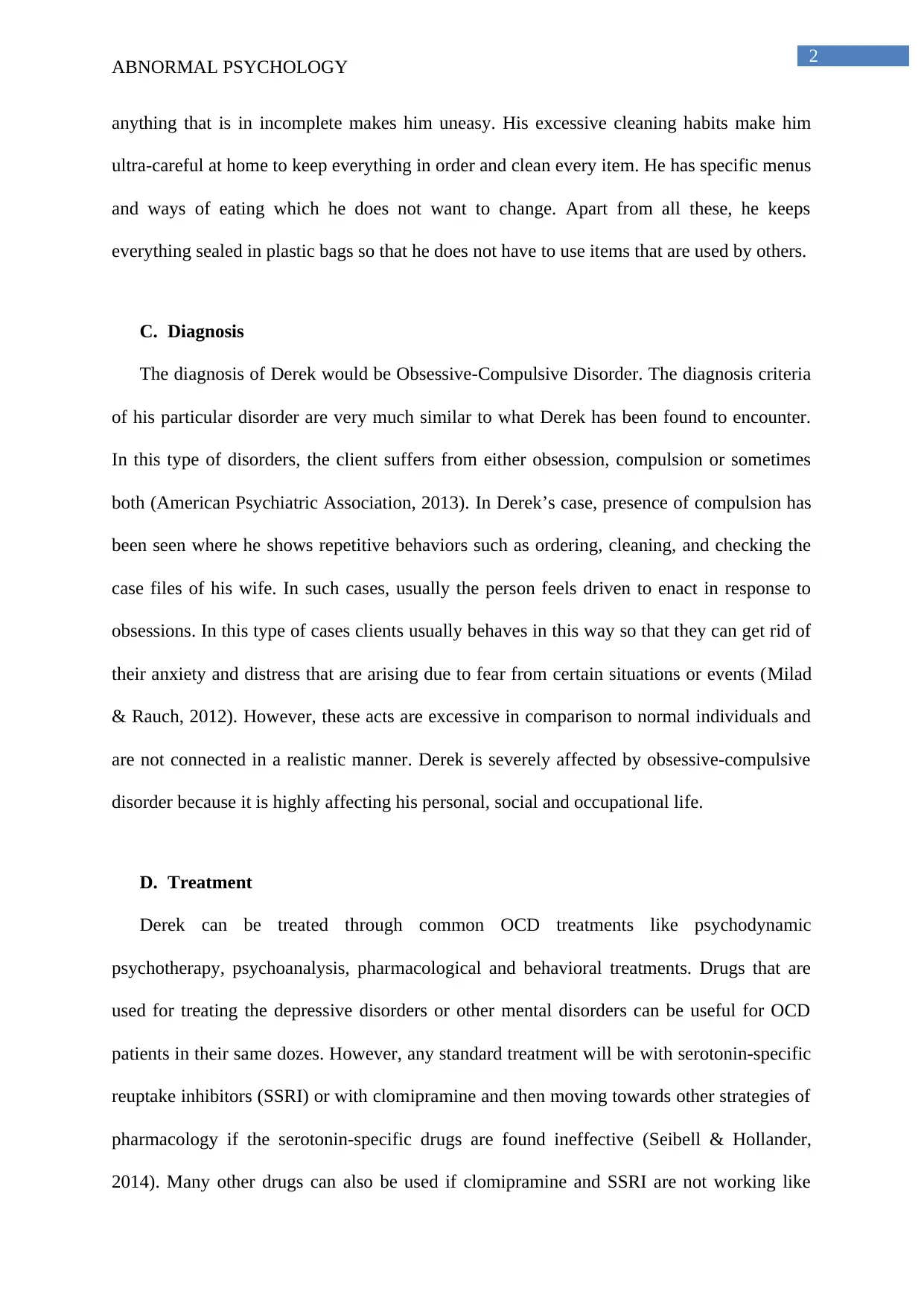
2
ABNORMAL PSYCHOLOGY
anything that is in incomplete makes him uneasy. His excessive cleaning habits make him
ultra-careful at home to keep everything in order and clean every item. He has specific menus
and ways of eating which he does not want to change. Apart from all these, he keeps
everything sealed in plastic bags so that he does not have to use items that are used by others.
C. Diagnosis
The diagnosis of Derek would be Obsessive-Compulsive Disorder. The diagnosis criteria
of his particular disorder are very much similar to what Derek has been found to encounter.
In this type of disorders, the client suffers from either obsession, compulsion or sometimes
both (American Psychiatric Association, 2013). In Derek’s case, presence of compulsion has
been seen where he shows repetitive behaviors such as ordering, cleaning, and checking the
case files of his wife. In such cases, usually the person feels driven to enact in response to
obsessions. In this type of cases clients usually behaves in this way so that they can get rid of
their anxiety and distress that are arising due to fear from certain situations or events (Milad
& Rauch, 2012). However, these acts are excessive in comparison to normal individuals and
are not connected in a realistic manner. Derek is severely affected by obsessive-compulsive
disorder because it is highly affecting his personal, social and occupational life.
D. Treatment
Derek can be treated through common OCD treatments like psychodynamic
psychotherapy, psychoanalysis, pharmacological and behavioral treatments. Drugs that are
used for treating the depressive disorders or other mental disorders can be useful for OCD
patients in their same dozes. However, any standard treatment will be with serotonin-specific
reuptake inhibitors (SSRI) or with clomipramine and then moving towards other strategies of
pharmacology if the serotonin-specific drugs are found ineffective (Seibell & Hollander,
2014). Many other drugs can also be used if clomipramine and SSRI are not working like
ABNORMAL PSYCHOLOGY
anything that is in incomplete makes him uneasy. His excessive cleaning habits make him
ultra-careful at home to keep everything in order and clean every item. He has specific menus
and ways of eating which he does not want to change. Apart from all these, he keeps
everything sealed in plastic bags so that he does not have to use items that are used by others.
C. Diagnosis
The diagnosis of Derek would be Obsessive-Compulsive Disorder. The diagnosis criteria
of his particular disorder are very much similar to what Derek has been found to encounter.
In this type of disorders, the client suffers from either obsession, compulsion or sometimes
both (American Psychiatric Association, 2013). In Derek’s case, presence of compulsion has
been seen where he shows repetitive behaviors such as ordering, cleaning, and checking the
case files of his wife. In such cases, usually the person feels driven to enact in response to
obsessions. In this type of cases clients usually behaves in this way so that they can get rid of
their anxiety and distress that are arising due to fear from certain situations or events (Milad
& Rauch, 2012). However, these acts are excessive in comparison to normal individuals and
are not connected in a realistic manner. Derek is severely affected by obsessive-compulsive
disorder because it is highly affecting his personal, social and occupational life.
D. Treatment
Derek can be treated through common OCD treatments like psychodynamic
psychotherapy, psychoanalysis, pharmacological and behavioral treatments. Drugs that are
used for treating the depressive disorders or other mental disorders can be useful for OCD
patients in their same dozes. However, any standard treatment will be with serotonin-specific
reuptake inhibitors (SSRI) or with clomipramine and then moving towards other strategies of
pharmacology if the serotonin-specific drugs are found ineffective (Seibell & Hollander,
2014). Many other drugs can also be used if clomipramine and SSRI are not working like
⊘ This is a preview!⊘
Do you want full access?
Subscribe today to unlock all pages.

Trusted by 1+ million students worldwide
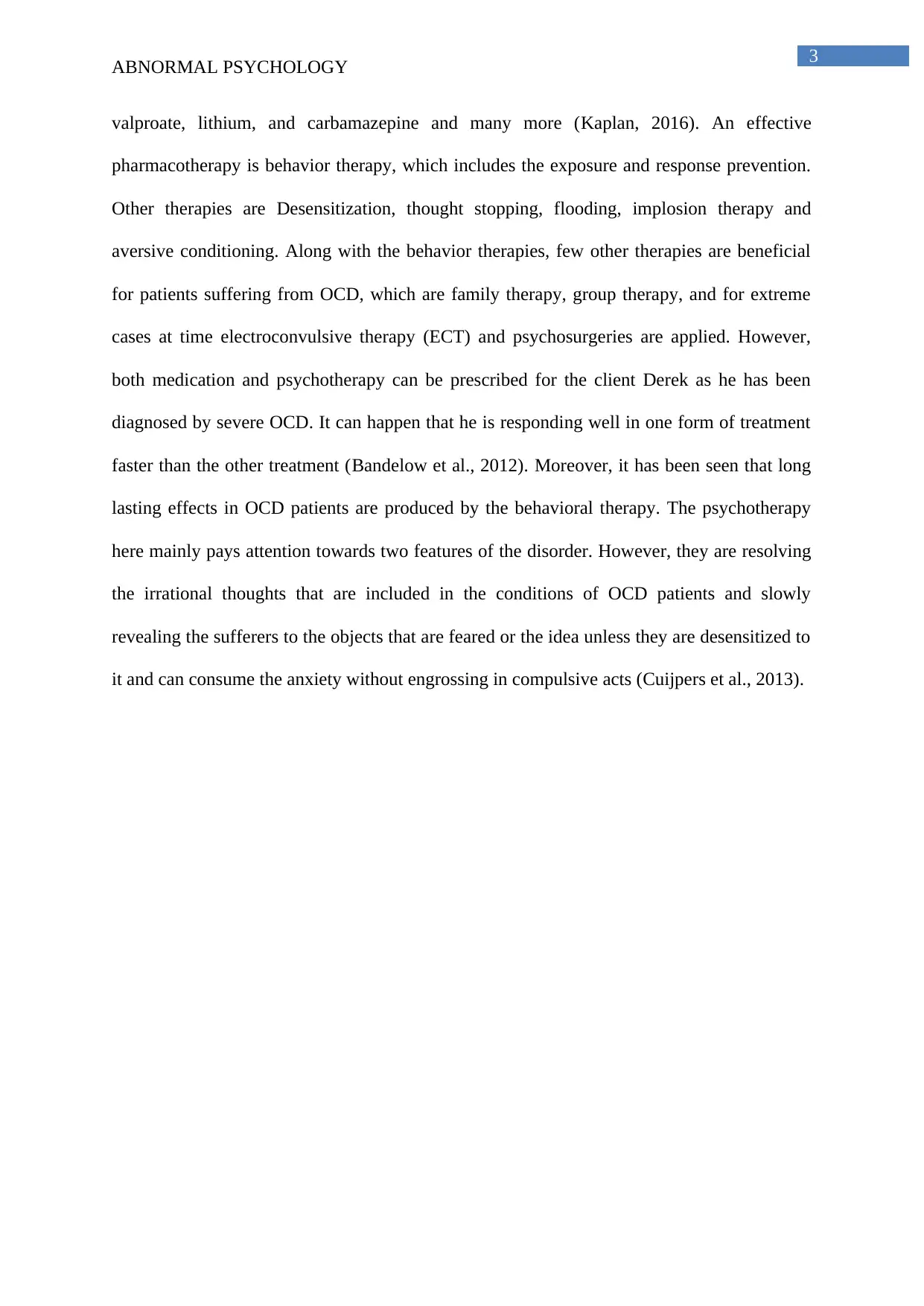
3
ABNORMAL PSYCHOLOGY
valproate, lithium, and carbamazepine and many more (Kaplan, 2016). An effective
pharmacotherapy is behavior therapy, which includes the exposure and response prevention.
Other therapies are Desensitization, thought stopping, flooding, implosion therapy and
aversive conditioning. Along with the behavior therapies, few other therapies are beneficial
for patients suffering from OCD, which are family therapy, group therapy, and for extreme
cases at time electroconvulsive therapy (ECT) and psychosurgeries are applied. However,
both medication and psychotherapy can be prescribed for the client Derek as he has been
diagnosed by severe OCD. It can happen that he is responding well in one form of treatment
faster than the other treatment (Bandelow et al., 2012). Moreover, it has been seen that long
lasting effects in OCD patients are produced by the behavioral therapy. The psychotherapy
here mainly pays attention towards two features of the disorder. However, they are resolving
the irrational thoughts that are included in the conditions of OCD patients and slowly
revealing the sufferers to the objects that are feared or the idea unless they are desensitized to
it and can consume the anxiety without engrossing in compulsive acts (Cuijpers et al., 2013).
ABNORMAL PSYCHOLOGY
valproate, lithium, and carbamazepine and many more (Kaplan, 2016). An effective
pharmacotherapy is behavior therapy, which includes the exposure and response prevention.
Other therapies are Desensitization, thought stopping, flooding, implosion therapy and
aversive conditioning. Along with the behavior therapies, few other therapies are beneficial
for patients suffering from OCD, which are family therapy, group therapy, and for extreme
cases at time electroconvulsive therapy (ECT) and psychosurgeries are applied. However,
both medication and psychotherapy can be prescribed for the client Derek as he has been
diagnosed by severe OCD. It can happen that he is responding well in one form of treatment
faster than the other treatment (Bandelow et al., 2012). Moreover, it has been seen that long
lasting effects in OCD patients are produced by the behavioral therapy. The psychotherapy
here mainly pays attention towards two features of the disorder. However, they are resolving
the irrational thoughts that are included in the conditions of OCD patients and slowly
revealing the sufferers to the objects that are feared or the idea unless they are desensitized to
it and can consume the anxiety without engrossing in compulsive acts (Cuijpers et al., 2013).
Paraphrase This Document
Need a fresh take? Get an instant paraphrase of this document with our AI Paraphraser
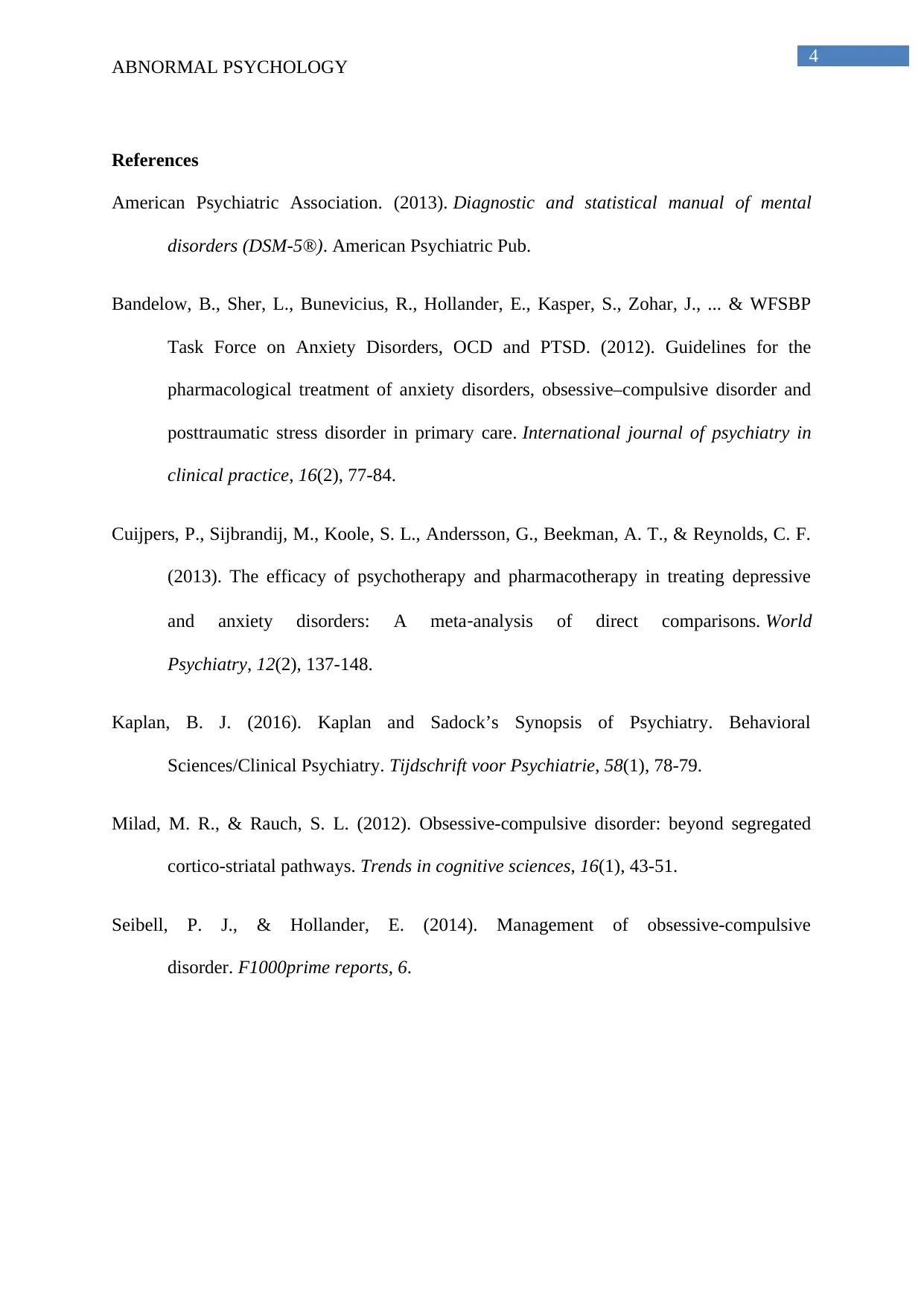
4
ABNORMAL PSYCHOLOGY
References
American Psychiatric Association. (2013). Diagnostic and statistical manual of mental
disorders (DSM-5®). American Psychiatric Pub.
Bandelow, B., Sher, L., Bunevicius, R., Hollander, E., Kasper, S., Zohar, J., ... & WFSBP
Task Force on Anxiety Disorders, OCD and PTSD. (2012). Guidelines for the
pharmacological treatment of anxiety disorders, obsessive–compulsive disorder and
posttraumatic stress disorder in primary care. International journal of psychiatry in
clinical practice, 16(2), 77-84.
Cuijpers, P., Sijbrandij, M., Koole, S. L., Andersson, G., Beekman, A. T., & Reynolds, C. F.
(2013). The efficacy of psychotherapy and pharmacotherapy in treating depressive
and anxiety disorders: A meta‐analysis of direct comparisons. World
Psychiatry, 12(2), 137-148.
Kaplan, B. J. (2016). Kaplan and Sadock’s Synopsis of Psychiatry. Behavioral
Sciences/Clinical Psychiatry. Tijdschrift voor Psychiatrie, 58(1), 78-79.
Milad, M. R., & Rauch, S. L. (2012). Obsessive-compulsive disorder: beyond segregated
cortico-striatal pathways. Trends in cognitive sciences, 16(1), 43-51.
Seibell, P. J., & Hollander, E. (2014). Management of obsessive-compulsive
disorder. F1000prime reports, 6.
ABNORMAL PSYCHOLOGY
References
American Psychiatric Association. (2013). Diagnostic and statistical manual of mental
disorders (DSM-5®). American Psychiatric Pub.
Bandelow, B., Sher, L., Bunevicius, R., Hollander, E., Kasper, S., Zohar, J., ... & WFSBP
Task Force on Anxiety Disorders, OCD and PTSD. (2012). Guidelines for the
pharmacological treatment of anxiety disorders, obsessive–compulsive disorder and
posttraumatic stress disorder in primary care. International journal of psychiatry in
clinical practice, 16(2), 77-84.
Cuijpers, P., Sijbrandij, M., Koole, S. L., Andersson, G., Beekman, A. T., & Reynolds, C. F.
(2013). The efficacy of psychotherapy and pharmacotherapy in treating depressive
and anxiety disorders: A meta‐analysis of direct comparisons. World
Psychiatry, 12(2), 137-148.
Kaplan, B. J. (2016). Kaplan and Sadock’s Synopsis of Psychiatry. Behavioral
Sciences/Clinical Psychiatry. Tijdschrift voor Psychiatrie, 58(1), 78-79.
Milad, M. R., & Rauch, S. L. (2012). Obsessive-compulsive disorder: beyond segregated
cortico-striatal pathways. Trends in cognitive sciences, 16(1), 43-51.
Seibell, P. J., & Hollander, E. (2014). Management of obsessive-compulsive
disorder. F1000prime reports, 6.
1 out of 5
Related Documents
Your All-in-One AI-Powered Toolkit for Academic Success.
+13062052269
info@desklib.com
Available 24*7 on WhatsApp / Email
![[object Object]](/_next/static/media/star-bottom.7253800d.svg)
Unlock your academic potential
Copyright © 2020–2025 A2Z Services. All Rights Reserved. Developed and managed by ZUCOL.





